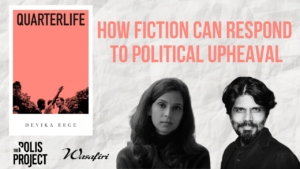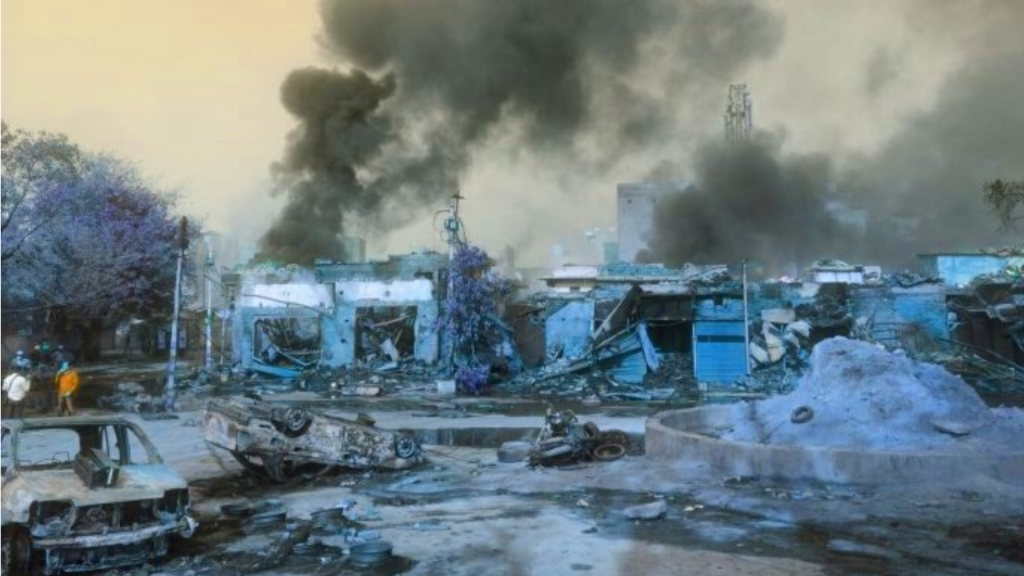
An account of fear and impunity – A preliminary fact finding report on communally-targeted violence in NE Delhi, February 2020


Starting on 23 of February 2020, North East Delhi’s Muslims communities witnessed a series of violent incidents, including the destruction of property, attacks on mosques and the death of at least fifty-three people. This report was compiled by the Youth for Human Rights (YHRD).
The fact-finding commenced on 26th February and the team visited the Guru Teg Bahadur hospital where many of the injured and the dead from the violence-affected regions were brought. The Team then visited the violence-affected area of Mustafabad and met victims/survivors from Shiv Vihar and Mustafabad area.
YHRD gathered first-hand testimonies of violence-struck individuals as well as other stakeholders including relief volunteers, members of civil society organizations, legal representatives, health rights activists, media, and the local politicians and leaders. The Report that comprises both primary and secondary data is an attempt to provide a holistic picture of pre- and post- violence scenarios of the Delhi violence while highlighting the role of various stakeholders in abetting or stopping the same. The team particularly sought the help of young individuals from the community who have been involved in the relief and rescue work in order to meet the affected families without being intrusive in such traumatic times. Through them, the videos and pictures circulated among the community related to the recent violence have also been accessed. Names of the testimony providers have been consciously omitted or changed so as to protect their identities.
As a part of our commitment to host, document, and archive the ongoing violence in India, The Polis Project is publishing this report.
You can access the original report prepared by YHRD here.
An Account of Fear & Impunity – Violence in NE Delhi – Full Report
Key findings
- Violent consequences of communal propaganda – The violence in North-East Delhi is not a standalone incident. It is the result of a series of communal propaganda which has instigated attacks on the Muslim community. This propaganda has been spread through provocative speeches at local as well as national level. The role of mainstream media has been critical in manufacturing bigotry and hatred against Muslims. While the violence was at its peak from 23 February until 26 February 2020 incidents of individual attacks have also taken place even after this period.
- Organised and targeted violence against Muslims – There is compelling evidence suggesting the intentional and pre-planned targeting of the persons, property and religious places of worship, belonging to the Muslim community residing in the violence-affected areas. Victims have been asked their religion before they were attacked. Testimonials and first-hand evidence point towards Muslim-owned businesses, shops and mosques being looted or burnt down in the violence while adjacent Hindu-owned shops and temples were not touched.
- Violent threat to Muslim religious identity – The testimonies of the victims highlight the acts of violence committed by the perpetrators that include religious and bigoted slurs, abuses, slogans, attacks on the religious symbols and places of worship. The affected community looks at this incident not only as an attack on their lives and property but also on their religious beliefs and dignity. Eye-witness accounts have testified to mob chanting “Jai Shree Ram” (glory to Lord Ram) and “Jai Siya Ram”. On the other hand, the victims/survivors shared that they had to hide their religious identity to save themselves.
- Hate Crimes – The acts of violence committed by the Hindu right-wing mob, Delhi Police and even certain sections of the Indian media were clearly motivated by bias and hate towards the Muslim community and thereby constitute as hate crimes under multiple sections of the Indian Penal Code.
- Lack of accountability – The fact that this particular attack lasted for more than 4 days in the national capital raises questions of accountability. The delay in prompt action has led to the loss of life and sizable destruction that could have been avoided. As per the latest figures published in media reports as on March 5, 2020, 53 people have died and many more have been injured as a direct result of this violence which has also led to the destruction of 122 houses, 322 shops, 301 vehicles and 3 schools. 16 Masjids of the area have been attacked by the mob who even placed a saffron flag on top of one of them.
- Affected areas – Primary areas in North East Delhi impacted by the violence include Shiv Vihar, Mustafabad (including Bhagirathi Vihar and Brijpuri), Chand Bagh, Maujpur, Gokulpuri, Kardampuri, Noor-e-Ilahi, Khajuri Khas and Bhajanpura. Out of these Shiv Vihar, Maujpur-Babarpur, Chand Bagh and Jaffrabad are mixed population areas, with lanes which are Hindu dominated, that left Muslims isolated and vulnerable. All these areas are marked by poor socio-economic indicators. The area also has a large population of migrant, daily wage workers from UP, Bihar & West Bengal.
- The ‘Blood Drain’, a perfect cover – An open drain that runs across most of the affected area has been used by the perpetrators to dump the bodies and severed body parts. While many bodies have already been retrieved from this drain, the community suspects many more will be retrieved when this drain is dredged.
- Impunity of the perpetrators – The perpetrators have carried out their actions with a significant amount of impunity and have continued to enjoy the same. The Fact-finding team heard gruesome accounts of many people being shot by firearms, stabbed with knives & swords, body cut into pieces and dumped in the drain and people being burnt alive in the fire. Media reports have carried chilling confessions of self-proclaimed ‘rioters’. The community blames the lackadaisical attitude of the criminal justice system and indifference of the Indian society at large for such a situation.
- Uncertainty over disappearances – As bodies are still being recovered, many Muslims of the violence-hit localities remain missing since 23rd February, including young children. Some families were only able to locate their relatives when searching through hospital wards and the morgue. Others have still received no news and have also faced difficulties in lodging a missing person complaint due to fear and lack of cooperation from the police.
- Gendered violence – The Team heard many accounts of rape and sexual violence reported by the community. An eyewitness account of a mob tearing clothes of children and girls and later throwing them in the fire was also shared. Sexual violence has historically remained under-reported in incidences of communal and mass violence.
- Partisan Role of the Delhi Police – The testimonies of multiple victims point towards the partisan role played by the Delhi Police during the violence. The allegations include inter alia omission in fulfilling their constitutional duties of maintaining law and order, facilitation and collusion with the Hindu right-wing mob, active participation in assault, murder and arson and destruction of religious places of worship. The police has also been directly and indirectly threatening the families of those killed in the violence, the injured, eye-witnesses and members of civil society organisations through arbitrary arrests, shielding of actual perpetrators especially in Hindu dominated areas and making worst affected areas inaccessible to media, Muslim community members and other civil society stakeholders, which points towards an attempt to destroy evidence.
- Arbitrary arrests & detentions – As per media reports published on 5 March, the police have claimed to have registered 654 cases related to the violence and 1820 people have been either arrested or detained. While it is difficult to verify this claim, people in the community state that the arbitrary arrests of their people have begun. There is a sense of fear in the community that the cases registered by the police will be used against the ones who have suffered. The community fears that the system is biassed against them.
- Complicity of the Criminal Justice System – The impacted community has expressed shock and angst towards the unprecedented complicity of the criminal justice system specifically that of the police. The news of the transfer of a ‘good’ High Court judge along with slowed down hearing and investigation processes have further contributed to intensifying the feeling of distrust in all systems of justice and grievance redressal mechanisms.
- Government inaction in relief & rescue work – In spite of extreme levels of despair and helplessness the community managed to spearhead relief and rescue work on their own without depending on government or civil society. The major part of rescue and relief work is still being managed by people from the community. Even though the Delhi Government has announced many relief measures; their impact is not visible on the ground yet. There is a sense of frustration in the affected community due to lack of prompt action from the state.
- Role of Medical Institutions – Violence affected individuals were largely brought to GTB, LNJP and Al-Hind hospital. Stories of neglect and bias have emerged along with an inordinate delay in conducting post mortem and providing requisite documents to the family of the deceased. Victims/survivors have struggled with covering the cost of their medical expenses even after the Delhi Government had announced free medical treatment.
- Displacement & further ghettoisation of Muslims – In the wake of communalized targeting of their homes and businesses, Muslims have begun leaving the violence struck localities leading to displacement and potential ghettoisation of violence inflicted community. Many Muslim families have been rendered homeless and have lost their personal belongings and furniture.
- Fear, angst and trauma – The Community has been largely relying on their own kin and acquaintances while being suspicious of any external help owing to their complete disillusionment with their neighbours and Hindu community at large. The Team encountered visible signs of shock, disbelief and trauma in the victim/survivor community members including incessant crying, blank demeanours and loss of appetite. Children were eyewitnesses to brutal violence and seem to have internalized the violence that they witnessed. The Team has had shocking encounters with children who showed them disturbing videos of the attack and also spoke in great detail about the violence.





